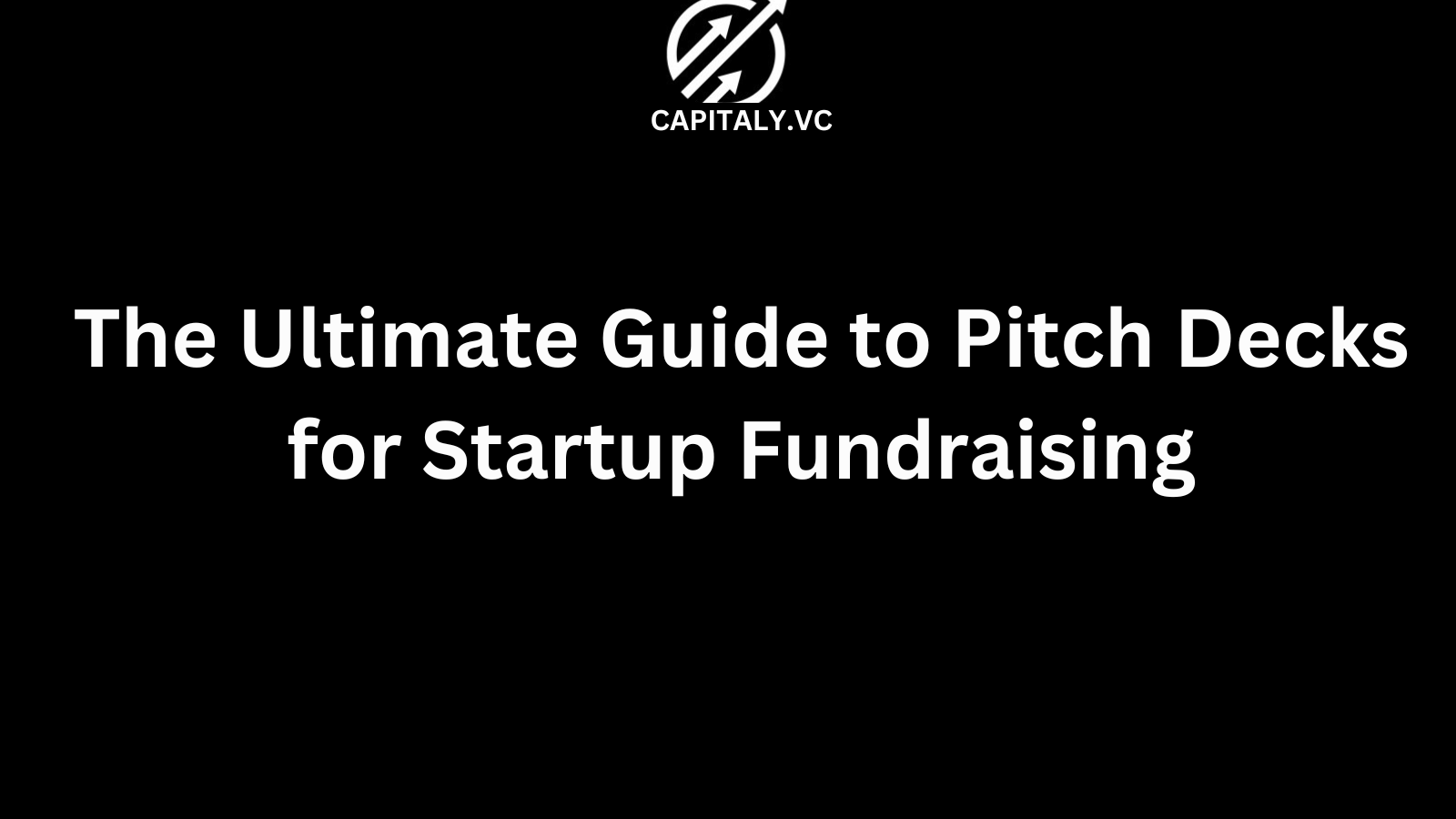The Ultimate Guide to Pitch Decks for Startup Fundraising
The Ultimate Guide to Pitch Decks for Startup Fundraising

Why Your Pitch Deck Matters More Than Ever in 2025
Your pitch deck is your startup’s passport to funding.
In 2025, investors are reviewing more decks than ever before.
AI tools now surface opportunities to VCs faster, which means your deck isn’t just competing with founders in your city—it’s competing globally.
A sloppy deck gets buried.
A well-structured one opens doors.

The Optimal Pitch Deck Structure for VC Attention
A pitch deck isn’t a random collection of slides.
It’s a story with a clear arc:
- Hook → Capture attention immediately.
- Problem → Show a real, urgent pain point.
- Solution → Demonstrate your unique approach.
- Business Model → Explain how you make money.
- Traction → Prove you can deliver.
- Financials → Show sustainability and upside.
- Team → Build trust.
- Call-to-Action → Tell them what’s next.
Crafting a Powerful Opening Slide That Hooks Investors
Your first slide should make investors stop scrolling.
Avoid generic mission statements.
Instead:
- Lead with a shocking statistic.
- Ask a thought-provoking question.
- Show a clear before/after transformation.
Example:
"50% of small businesses fail in 3 years. Ours cuts that risk in half."
Data-Backed Metrics to Include in Your Deck
Investors trust numbers more than adjectives.
Focus on:
- Monthly recurring revenue (MRR).
- Customer acquisition cost (CAC).
- Lifetime value (LTV).
- Growth rate (MoM or YoY).
Keep the visuals clean—no investor wants to read a spreadsheet on a slide.
For more on what data VCs value most, see our blog post: Exact Metrics Investors Will Look For in 2025.
How to Present Your TAM, SAM, and SOM Effectively
Your Total Addressable Market (TAM), Serviceable Available Market (SAM), and Serviceable Obtainable Market (SOM) need more than big numbers.
Show your research methodology.
Highlight market trends backing your projections.
Use visuals to break it down, not paragraphs.
Building a Strong Problem Statement
A weak problem statement sinks good ideas.
State the pain point in human terms.
Use a short story or example that puts the investor in the customer’s shoes.
If the problem isn’t clear, they’ll never buy the solution.
Presenting the Solution and Product Demo Effectively
Don’t just explain—show.
A quick demo, animated mockup, or before/after comparison works wonders.
Keep it under 60 seconds if presenting live.
If asynchronous, make the video autoplay silently with captions.
How to Showcase Your Business Model Clearly
If your revenue model is complex, simplify it visually.
Include:
- Who pays.
- How much.
- How often.
Show unit economics if you’re scaling.
The Right Way to Present Traction and Growth Data
Traction is proof.
Highlight user growth, revenue milestones, partnerships, or media mentions.
Avoid vanity metrics—1,000 app downloads mean nothing if churn is 90%.
For more on how to validate traction before fundraising, see our blog post: How to Build an Investor-Ready Business Case.
Financial Projections That Inspire Confidence
Make them conservative yet compelling.
Investors will mentally cut your numbers in half—so start realistic.
Use 3–5 years of projections and clearly show underlying assumptions.
Presenting Your Team to Build Credibility
Investors bet on people, not just products.
Show relevant experience, exits, and domain expertise.
Include advisors if they carry weight.
Handling Competition Slides Without Undermining Your Case
Never say “we have no competitors.”
Instead:
- Use a feature vs. competitor matrix.
- Highlight your moat—technology, partnerships, IP.
- Show why you win long-term.
The Art of the Closing Slide and Call to Action
Your last slide should tell investors what to do next.
Example: “We’re raising $2M to expand into 3 new markets—let’s talk.”
Include your contact details, not just a logo.
Using AI Tools for Pitch Deck Design and Optimization
AI can help refine your pitch deck:
- ChatGPT for refining storytelling.
- Beautiful.ai for automated slide layouts.
- Tome for AI-first presentations.
Test multiple versions and let data guide which one you use.
For more on AI in fundraising, see our blog post: Using AI Tools to Accelerate Fundraising Outreach.
Templates and Examples That Win Investor Trust
Study decks from Airbnb, Uber, and Stripe.
Notice how they simplified complex concepts.
Don’t copy—adapt the framework to your story.
FAQs
1. How long should my pitch deck be?
10–15 slides max. Enough to spark interest, not tell your life story.
2. Do I need to include financial projections?
Yes. Even early-stage startups should show directional numbers.
3. Should I send the deck before the meeting?
If asked, yes—but use a slightly stripped-down version to create curiosity.
4. How important is design?
Very. A bad design signals lack of attention to detail.
5. Can I use AI to create my pitch deck?
Yes, but review and refine to ensure accuracy and human touch.
6. How do I handle tough questions after presenting?
Be honest, admit what you don’t know, and offer to follow up.
7. Should I add customer testimonials?
If they’re strong and relevant—yes.
8. How do I present traction without huge numbers?
Show growth rate, early partnerships, or market validation.
9. What’s the most common mistake founders make?
Overloading slides with text and jargon.
10. When should I update my pitch deck?
Anytime there’s a major milestone—funding round, traction jump, or new market entry.
Conclusion
A great pitch deck isn’t just slides—it’s a strategic tool to win investor trust.
By structuring it well, focusing on data-backed claims, and presenting with clarity, you increase your odds of securing funding.
If you want to master the art of pitch decks for startup fundraising, start applying these principles today.
Subscribe to Capitaly.vc to raise capital at the speed of AI.


.png)